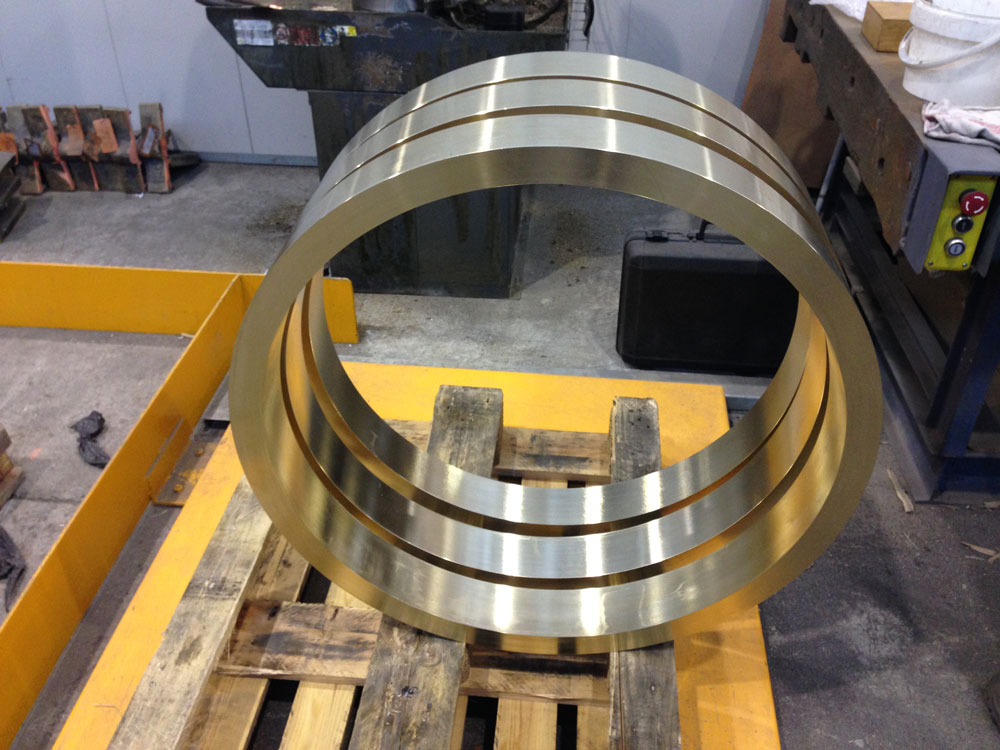Corrosion issues are of major importance in a marine environment due to the highly corrosive nature of seawater. However, reliable solutions do exist; most are based on cathodic protection, coated steel or stainless steels, but another category of alloys is available; Nickel Aluminium Bronze alloys.
By Olivier Gouriou, INOXYDA
Nickel Aluminium Bronze, also called NAB alloys, are copper-based alloys with nickel, aluminium and iron in various proportions, leading to different mechanical properties. Most of these alloys are well documented in various norms, such as ASTM B148, EN 1982, BS14000 or in technical literature such as the Guide to Nickel Aluminium Bronze published by the Copper Development Association. In reading this literature, we find out that NABs seawater corrosion resistance is due to its self-repairing film, which outlasts most steel coated solutions. However, it has other interesting properties, including:
• High strength
• Density (5% lighter than steel)
• Non-sparking
• Low magnetic permeability
(of <1.03µ in selected grades)
• High corrosion resistance
• Good cryogenic properties
• High resistance to biofouling
• Lower cost than titanium
In addition to these properties, we can add very good machinability and ease of weld repairs, which lead to various available manufacturing processes.


NAB manufacturing processes
As a material widely used in engineered products, NAB alloys are available in different forms supported by international standards as reference points.
Continuous casting
° For billets used for forging or directly machining various small mechanical components
Sand casting
° For larger & complex engineered parts to be machine finished before assembly
Centrifugal casting
° For cylinder based parts, also to be machine finished
Forgings
° Same as above, based on initial casted billets
Plates
° For welded constructions
Drawn bars
° For various axles and very small machined parts
As NABs are easily available, machinable and repairable, they allow a wide variety of applications.
Engineerd applications
Due to their suitability for seawater environments, NABs are commonly used in the following applications:
• Pumps: impellers, casings, discharge elbows
• Valves: bodies, discs, wedges, bonnets
• Heat exchangers: channels, tube-sheets, floating heads, covers
• Propulsion: blades, hubs, bearings,
• Renewable energy: Kaplan blades, ball bearing cages
Various applications for which standard alloys are not always sufficient but for which custom alloys are available, for example:
• Inoxyda 53AMA and Inoxyda 3PAMA: for low magnetic permeability < 1.05
° Applications: mine hunter propulsion lines
• Inoxyda 154 (sand casting or forging): for high mechanical properties ( TS > 750 MPa)
° Applications: underwater electronic casings and couplings
• Inoxyda 3Cryo: for resistance to low temperature
° Applications: cryogenic valves and pumps
Quality controls
All shipbuilding industry applications are under the very strict control of major classification societies such as DNVGL, Lloyds, Bureau Veritas, RINA, RMRS. They are subject to certifications that go beyond the basic ISO 9001 certification, including PED (Pressure Equipment Directive 2014/68/EU) and, in some cases, end-user qualifications. Classification societies regularly require several controls to guarantee the quality of the parts, including:
° Inspection and test plans
° Dye penetrant test
° Dimensional and Pressure test
° UL thickness measurement
° X-rays ( in particular for high- pressure applications)
All of these are applicable to all aluminium bronze manufacturing processes mentioned above.
Summary
Due to its properties, Nickel Aluminium Bronze is an option to be considered compared to other coated or stainless steels alloys when confronted with seawater corrosion, biofouling or non-sparking issues. If cost is a significant factor, remember that 60% of the raw material cost can be recovered when the material is scrapped, thus further improving your TCO.
For more detailed technical data, the reader can consult the guide to Nickel Aluminium Bronze for Engineers (by Ivan Richardson – Metallurgical Consultant), published by the Copper Development Association.
About the author: Olivier Gouriou
 “I have been in charge of Aluminium Bronze alloys at Inoxyda for the past five years. I’m regularly confronted with engineers needing to choose the most appropriate material for seawater corrosion issues and find that they lack technical data on NAB alloys and their applications. I’m an enthusiast of all the various applications for valves, pumps, heat exchangers and propulsion, and am keen to share technical data and experience, so feel free to contact me.
“I have been in charge of Aluminium Bronze alloys at Inoxyda for the past five years. I’m regularly confronted with engineers needing to choose the most appropriate material for seawater corrosion issues and find that they lack technical data on NAB alloys and their applications. I’m an enthusiast of all the various applications for valves, pumps, heat exchangers and propulsion, and am keen to share technical data and experience, so feel free to contact me.
Email: olivier.gouriou@inoxyda.fr
Every week we share a new Featured Story with our Stainless Steel community. Join us and let’s share your Featured Story on Stainless Steel World online and in print.
Featured Story by: Olivier Gouriou, INOXYDA
All images were taken before the COVID-19 pandemic, or in compliance with social distancing.



 “I have been in charge of Aluminium Bronze alloys at Inoxyda for the past five years. I’m regularly confronted with engineers needing to choose the most appropriate material for seawater corrosion issues and find that they lack technical data on NAB alloys and their applications. I’m an enthusiast of all the various applications for valves, pumps, heat exchangers and propulsion, and am keen to share technical data and experience, so feel free to contact me.
“I have been in charge of Aluminium Bronze alloys at Inoxyda for the past five years. I’m regularly confronted with engineers needing to choose the most appropriate material for seawater corrosion issues and find that they lack technical data on NAB alloys and their applications. I’m an enthusiast of all the various applications for valves, pumps, heat exchangers and propulsion, and am keen to share technical data and experience, so feel free to contact me.